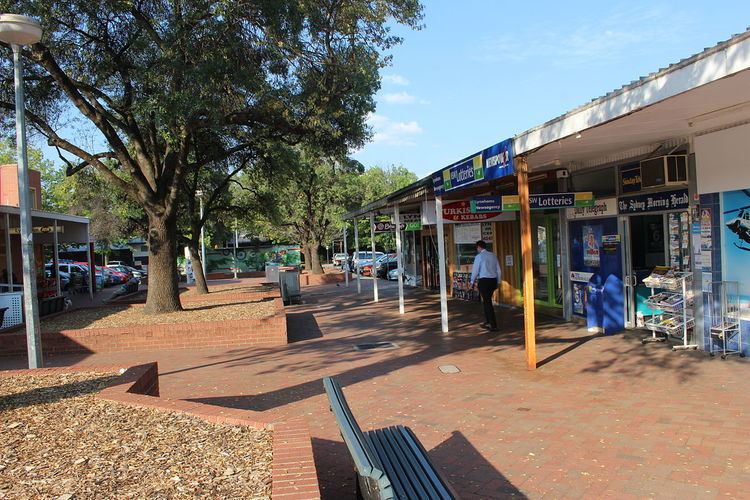Population 4,484 (2011 census) Postcode(s) 2602 Area 5.5 km² Postal code 2602 Federal division Division of Fenner | Established 1928 Founded 1928 Local time Thursday 3:04 AM | |
 | ||
Weather 18°C, Wind E at 6 km/h, 81% Humidity | ||
Lyneham is a suburb of Canberra, Australia in the North Canberra district. It is named after Sir William Lyne, premier of the Australian state of New South Wales from 1899 to 1901. The suburb name was gazetted in 1928, but development did not commence until 1958. The streets of Lyneham are named after artists and people associated with the development of early Canberra.
Contents
- Map of Lyneham ACT 2602 Australia
- Points of interest
- Character
- North Lyneham
- Demographics
- Politics
- Education
- Geology
- References
Map of Lyneham ACT 2602, Australia
Points of interest
Lyneham has many attractions including nature parks and bushland, proximity to the centre of Canberra, popular cafes including the famous Tilley's Devine Cafe and Gallery as well as the Front Cafe and Gallery, and a number of sporting facilities including the National Hockey Centre, Canberra Racecourse and the ACT Netball Centre.
Also located in Lyneham is Exhibition Park in Canberra (EPIC), which annually hosts Australia's best known car festival, Summernats, the Royal Canberra Show and the National Folk Festival.
St Ninian's Uniting Church in Brigalow Street is the second-oldest church in Canberra, opened in 1873. It was founded as a Presbyterian Church by the Scottish community, many of whom had come to the area as shepherds. It has been heritage-listed by the ACT Heritage Council.
Character
The style of the suburb has been evolving since development commenced in 1958 at the north-western periphery of what is now 'inner' Canberra. The older homes built in 1958-59 (many of which catered to the sizeable influx of Commonwealth Public Servants' families, who were being relocated with their respective Departments' headquarters from Melbourne), now sit beside modern townhouse developments, while individual blocks are being 'gentrified' by either extensive renovation or demolition and rebuilt homes. Having mainly been substantially established since the 1960s, Lyneham residents enjoy its leafy streets and established gardens. A scenic wetland was built adjacent to Sullivans Creek in Lyneham to improve downstream water quality. It was opened to the public in April 2012 and it is frequented by wood ducks.
Many of the single houses between Sullivans Creek and Northbourne Avenue have been replaced by two and three storey flats in recent years. Land adjoining Northbourne Avenue is now zoned to permit redevelopment with 25 metre (about 8 storeys) high flats or 32 metres (about 11 storeys) at the corners of Mouat Street and Macarthur Avenue with Northbourne Avenue and the first such flats were completed on the site of a two-storey motel on the corner of Northbourne Ave and Mouat St in 2013.
North Lyneham
The residential part of Lyneham built to the north of Ginninderra Drive having been developed in the mid to late 1980s was a relatively recent addition to the original suburban homes of 1960s' Lyneham. The original residences on "old" Lyneham, contained within the area bounded by Wattle, Dyandra, Archibald and Mouat Streets and Northbourne Avenue mainly date back to the late 1950s. North Lyneham's main feeder road, Cossington Smith Crescent, loops through the area with other streets coming off it. North Lyneham also has a small shopping centre housing shops, a couple of restaurants and a number of small businesses. North Lyneham backs onto a bush reserve which separates it from the Belconnnen suburb of Kaleen. The walking trails in the reserve are popular with the local residents and provide scenic views of the inner northern suburbs of Canberra to the east and south and Belconnen and the Brindabella Ranges to the west.
Demographics
In the 2011 Census, the population of Lyneham was 4,484, including 35 (0.8%) Indigenous persons and 2,877 (64.1%) Australian-born persons. Only 36.5% of dwellings were separate houses (compared to the Australian average of 75.6%), while 39.4% were semi-detached, row or terrace houses (Australian average: 9.9%) and 24.0% were flats, units or apartments (Australian average: 13.6%). 41.5% of the population were professionals, compared to the Australian average of 21.3%. Notably 20.8% worked in government administration, compared to the Australian average of 1.3%, although the Canberra-wide average is a very similar 20.1%. Lyneham is favoured by students and young adults with 32.8% of its population in the 20- to 34-year-old age group (compared to the Australian average of 20.6%). The suburb has few children under 15: 10.8%, compared to 19.3% Australia-wide. 35.5% of the dwellings are occupied by single person households, compared to the Australian average of 24.3%. 36.5% of the population had no religion, while 18.8% were Catholic and 10.7% were Anglican.
Politics
Lyneham is located within the federal electorate of Fenner and it is represented by Andrew Leigh for the Labor Party. In the ACT Legislative Assembly, Lyneham is part of the electorate of Kurrajong, which elects five members on the basis of proportional representation, two Labor, two Liberal and one Greens. Polling place statistics are shown to the right for the Lyneham polling place at Lyneham Primary School in the 2016 federal and 2016 ACT elections.
Education
Lyneham is home to Lyneham High School, Lyneham Primary School and Brindabella Christian College.
Geology
Silurian calcareous shales from the Canberra Formation is overlain by Quaternary alluvium. This rock is the limestone of the original title of Canberra "Limestone Plains". Greywacke from the Ordovician age Pittman Formation is in the north west.
